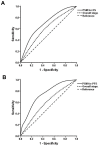Genetic variations in radiation and chemotherapy drug action pathways and survival in locoregionally advanced nasopharyngeal carcinoma treated with chemoradiotherapy
- PMID: 24340057
- PMCID: PMC3858314
- DOI: 10.1371/journal.pone.0082750
Genetic variations in radiation and chemotherapy drug action pathways and survival in locoregionally advanced nasopharyngeal carcinoma treated with chemoradiotherapy
Abstract
Background and purpose: Treatment outcomes vary greatly in patients with nasopharyngeal carcinoma (NPC). The purpose of this study is to evaluate the influence of radiation and chemotherapy drug action pathway gene polymorphisms on the survival of patients with locoregionally advanced NPC treated with cisplatin- and fluorouracil-based chemoradiotherapy.
Material and methods: Four hundred twenty-one consecutive patients with locoregionally advanced NPC were prospectively recruited. We utilized a pathway approach and examined 18 polymorphisms in 13 major genes. Polymorphisms were detected using the LDR-PCR technique. Multifactor dimensionality reduction (MDR) analysis was performed to detect potential gene-gene interaction.
Results: After adjustment for clinicopathological characteristics, overall survival was significantly decreased in patients with the MPO rs2243828 CT/CC genotype (HR=2.453, 95% CI, 1.687-3.566, P<0.001). The ERCC1 rs3212986 CC (HR=1.711, 95% CI, 1.135-2.579, P=0.010), MDM2 rs2279744 GT/GG (HR=1.743, 95% CI, 1.086-2.798, P=0.021), MPO rs2243828 CT/CC (HR=3.184, 95% CI, 2.261-4.483, P<0.001) and ABCB1 rs2032582 AT/AA (HR=1.997, 95% CI, 1.086-3.670, P=0.026) genotypes were associated with poor progression-free survival. Prognostic score models based on independent prognostic factors successfully classified patients into low-, intermediate-, and high-risk groups. Furthermore, MDR analysis showed no significant interaction between polymorphisms.
Conclusions: Four single nucleotide polymorphisms were associated with survival in patients with locoregionally advanced NPC treated with cisplatin- and fluorouracil-based chemoradiotherapy. Combining clinical prognostic factors with genetic information was valuable in identifying patients with different risk.
Conflict of interest statement
Figures




Similar articles
-
Functional polymorphisms of matrix metalloproteinase-9 and survival in patients with locoregionally advanced nasopharyngeal carcinoma treated with chemoradiotherapy.Med Oncol. 2013 Dec;30(4):685. doi: 10.1007/s12032-013-0685-6. Epub 2013 Aug 18. Med Oncol. 2013. PMID: 23955812 Clinical Trial.
-
Predictive value of excision repair cross- complementation group 1 expression in locoregionally advanced nasopharyngeal carcinoma receiving cisplatin-based concurrent chemoradiotherapy.Cancer Biomark. 2018;21(4):875-881. doi: 10.3233/CBM-170817. Cancer Biomark. 2018. PMID: 29439312
-
Induction chemotherapy with lobaplatin and fluorouracil versus cisplatin and fluorouracil followed by chemoradiotherapy in patients with stage III-IVB nasopharyngeal carcinoma: an open-label, non-inferiority, randomised, controlled, phase 3 trial.Lancet Oncol. 2021 May;22(5):716-726. doi: 10.1016/S1470-2045(21)00075-9. Epub 2021 Apr 12. Lancet Oncol. 2021. PMID: 33857411 Clinical Trial.
-
Effect of induction chemotherapy with cisplatin, fluorouracil, with or without taxane on locoregionally advanced nasopharyngeal carcinoma: a retrospective, propensity score-matched analysis.Cancer Commun (Lond). 2018 May 10;38(1):21. doi: 10.1186/s40880-018-0283-2. Cancer Commun (Lond). 2018. PMID: 29764487 Free PMC article.
-
Association of Chemoradiotherapy Regimens and Survival Among Patients With Nasopharyngeal Carcinoma: A Systematic Review and Meta-analysis.JAMA Netw Open. 2019 Oct 2;2(10):e1913619. doi: 10.1001/jamanetworkopen.2019.13619. JAMA Netw Open. 2019. PMID: 31626318 Free PMC article.
Cited by
-
Polymorphisms in ERCC5 rs17655 and ERCC1 rs735482 Genes Associated with the Survival of Male Patients with Postoperative Oral Squamous Cell Carcinoma Treated with Adjuvant Concurrent Chemoradiotherapy.J Clin Med. 2019 Jan 1;8(1):33. doi: 10.3390/jcm8010033. J Clin Med. 2019. PMID: 30609649 Free PMC article.
-
Can pharmacogenetics explain efficacy and safety of cisplatin pharmacotherapy?Front Genet. 2014 Nov 14;5:391. doi: 10.3389/fgene.2014.00391. eCollection 2014. Front Genet. 2014. PMID: 25452763 Free PMC article. Review.
-
Gene polymorphisms and prognosis of head and neck squamous cell carcinoma: a systematic review.Rep Pract Oncol Radiother. 2022 Dec 29;27(6):1045-1057. doi: 10.5603/RPOR.a2022.0109. eCollection 2022. Rep Pract Oncol Radiother. 2022. PMID: 36632296 Free PMC article. Review.
-
The Relevance of Regenerating Gene 1a Polymorphisms to Radiation Sensitivity and Survival of Nasopharyngeal Carcinoma Receiving Radiotherapy in a Southern Chinese Population.Pharmgenomics Pers Med. 2021 Nov 6;14:1403-1413. doi: 10.2147/PGPM.S328285. eCollection 2021. Pharmgenomics Pers Med. 2021. PMID: 34785928 Free PMC article.
-
Genetic polymorphisms of long non-coding RNA GAS5 predict platinum-based concurrent chemoradiotherapy response in nasopharyngeal carcinoma patients.Oncotarget. 2017 Jul 31;8(37):62286-62297. doi: 10.18632/oncotarget.19725. eCollection 2017 Sep 22. Oncotarget. 2017. PMID: 28977945 Free PMC article.
References
-
- Al-Sarraf M, LeBlanc M, Giri PG, Fu KK, Cooper J, et al. (1998) Chemoradiotherapy versus radiotherapy in patients with advanced nasopharyngeal cancer: phase III randomized Intergroup study 0099. J Clin Oncol 16: 1310-1317. - PubMed
-
- Wee J, Tan EH, Tai BC, Wong HB, Leong SS et al. (2005) Randomized trial of radiotherapy versus concurrent chemoradiotherapy followed by adjuvant chemotherapy in patients with American Joint Committee on Cancer/International Union against cancer stage III and IV nasopharyngeal cancer of the endemic variety. J Clin Oncol 23: 6730-6738. doi:10.1200/JCO.2005.16.790. PubMed: 16170180. - DOI - PubMed
Publication types
MeSH terms
Substances
LinkOut - more resources
Full Text Sources
Other Literature Sources
Research Materials
Miscellaneous

